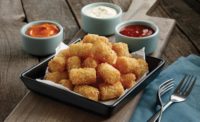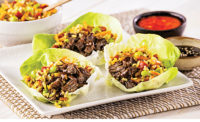The Main Course

Restaurants are facing pressures on multiple fronts right now. Federal and local government regulations are impacting how restaurants market and develop their menus. The potential for rising ingredient and labor costs is an annual threat to the balance sheets. Also, a weaker than expected economic recovery has hampered restaurants’ ability to thrive or even survive coming out of the recession. These pressures are taking place against the backdrop of ever-changing consumer tastes and marketplace trends, making the restaurants’ job more difficult.
To that end, restaurants need to have clear direction in their menu and concept development. Just listing menu items that have traditionally worked is not a guarantee for success anymore. As more pressure is applied to operators to stay on top of consumer and flavor trends, foodservice manufacturers play a critical role in helping customers and clients ensure what is listed on the menu moves. It is not just about pushing product into kitchens; it is about delivering the right kind of food with the right insight on menu development. For those manufacturers focusing on the right side of the menu, specifically entrees and sandwiches, the opportunities for new product development are balanced by the challenges facing operators and consumers.
The Main Plate: Comforting, Shareable and Healthy
Perhaps no menu section gets read more than the entrees section. The single plate dish that can focus on one singular ingredient--like steak--or complexly tie together multiple, seemingly incompatible ingredients, is the unquestionable superstar of the menu. Scanning the headlines, this is still where the action is. Meatless Mondays. Gluten Free. Big Appetite Section. There is so much news, it all ends up as noise. But, perhaps nothing points more to what is coming next in entree trends than what consumers want; seemingly, it appears the economy may be driving what they want.
According to Mintel, when asked what menu items they would like to see more of, 36% of respondents said old-fashioned/comfort foods, indicating that, as much as consumers may be longing for better days than they have experienced over the past few years, they may also be less inclined to try new and unfamiliar dishes. If dining out has become a special occasion, and it has for many consumers who have cut back, then what consumers order has to be a guaranteed winner.
Even shareable menu items (35%), the second-most requested menu item patrons want to see more of, underscores how consumers are dealing with their new economic realities. Instead of ordering one large entree for themselves, people are ordering numerous small plates or even pizza, with the cost spread against the entire party. Doing this may still allow for the experimentation they seek when dining out, while staying within their desired budget.
It is an inescapable fact that health concerns are always going to be a top want for restaurant goers. But this time, the desire for healthier menu items is getting a boost from the federal government, which is requiring calorie count and nutritional information disclosure at chain restaurants, starting next year.
By the Slice
To its credit, restaurants have recognized the new reality consumers are facing. Although restaurants have long been known for steak and chicken entrees--and those are still appearing on menus--other items are designed to meet consumer demands for both shareable and healthy menu items. Pizza is a naturally shareable item, often economical at its priciest; it can be customized to any number of tastes with toppings from multiple manufacturers. The new Four Seasons pizza from California Pizza Kitchen is a good example of a simple dish hitting multiple wants. With imported Italian tomatoes, artichoke hearts, salami, fresh mushrooms and other vegetables, the pizza appeals to the diner looking for an authentic take on a familiar dish, while also being positioned as a healthier option.
Healthy Fins
Beyond pizza, there is a definite uptick in new seafood dishes, led by heart-healthy salmon. For restaurants, seafood offers a way for restaurant operators and manufacturers to address demands for healthier fare, without losing flavor. According to Mintel Menu Insights, those menu items described as “healthy” grew 63% from the second quarter of 2009 to the same period in 2010. In many cases, fish can serve as a blank canvas for the kitchen, showcasing various flavors.
Even a strongly and distinctively flavored fish like salmon can take on richly flavored sauces and offer an opportunity to broaden the appeal of an existing menu item. Bourbon, honey, garlic and dill flavors all can be added to fish, either through spice rubs or sauces, to ensure that flavor is part of eating healthy.
It is those flavors that offer the greatest opportunity for restaurant operators and manufacturers over the next year. With operators looking to cut their costs, menu additions may slow. Simply put, it can be expensive to offer new menu items, but it can be a death knell to list a staid menu. Mixing up flavors and literally spicing up current menu items with new flavor profiles can rejuvenate a tired menu. Among the fastest-growing entree flavors, restaurants are taking multiple approaches to enhancing their current offerings. Latin American flavor profiles, like guajillo pepper and achiote, are listed alongside Asian and regional American flavors.
That there is no overwhelming flavor trend among entrees opens up how restaurants and manufacturers can approach menu development. Instead of being bound to a particular trend, menu items should incorporate the flavors most appropriate for that dish, and manufacturers, with their culinary expertise and resources, are in many cases the best place for a restaurant to turn to when revamping dishes.
Trends in Sandwiches
In many ways, the same trends that are driving what is being listed as the main dish also are driving trends in sandwiches. Restaurant-goers are nostalgic for what they liked when they were younger, yet are still practical enough to understand that, in some cases, they have to act more frugally than in the past.
For restaurants, this has resulted in sandwiches that make use of familiar ingredients, but are presented in new ways or even at new times.
Wake Up and Smell the Breakfast Sandwich
Perhaps nothing is becoming more important for restaurants than the breakfast sandwich. Faced with declining customer traffic, restaurants are looking to boost sales by entering a new daypart--breakfast--and they are leading with the breakfast sandwich. Burger King’s anticipated breakfast menu has not yet been revealed, though past market tests included a ciabatta breakfast sandwich, illustrating the breakfast sandwich can be an original idea.
The relatively low price point of breakfast sandwiches (priced at about $4.18, according to Mintel Menu Insights) make them appealing to cash-strapped customers. In addition, restaurants are able to drive business in the morning hours, typically a neglected daypart, and potentially increase sales in the afternoon, as Subway has done with its breakfast sandwich program. According to the company, its new breakfast sandwich line has also boosted traditional sandwich sales, as customers order their lunch sandwiches while picking up breakfast in the morning.
Snackable Sandwiches
One of the biggest trends in sandwiches involves not what is going into the sandwiches, but how they are being prepared and presented. “Mini” sandwiches appear as one of the top new sandwiches added to menus during the second quarter of 2010, and wraps have become a notable success for multiple restaurant chains, most especially McDonald’s. Since launching its Chicken Snack Wraps, the snack wrap line has grown to include new varieties, including the most recent incarnation, the Angus Snack Wrap.
As with innovations with entrees, the appeal for restaurants is that these smaller versions of sandwiches already make use of existing ingredients and culinary know-how. Little training is required for incorporating these items into a menu, and the items often build upon already successful regular-sized offerings. However, these smaller items do offer an opportunity for new sauces, spices and flavors that may be cost-prohibitive in regular-sized portions.
Bring on the Meat
Some establishments are creating sandwiches that fly in the face of consumer demands for healthier fare: the multiple sandwich “sandwiches.” To call them sandwiches is not entirely accurate; they are more precisely burgers topped with sandwiches or sandwiches framing burgers. The Carl’s Jr. Philly Cheesesteak Burger tops a beef patty with sautéed steak. At Friendly’s, the new Grilled Cheese BurgerMelt eschews the traditional bun for two grilled cheese sandwiches. Even though these types of items ignore movements in healthier fare, they draw upon the novelty and indulgence some customers look for when dining out. While these items may not be appropriate for everyday eating, they offer an opportunity for developing a distinctive and memorable menu.
Looking Ahead
It appears the rest of 2010 and, at least, the start of 2011 will be a struggle for restaurants. A weak economy has deterred people from dining out. For restaurants, tweaking existing items may not be as exciting as menu revamps, but those slight changes may hit on what consumers want or offer new opportunities for manufacturers. Understanding what restaurant-goers seek next offers the best insight into future restaurant menu trends. pf
Looking for a reprint of this article?
From high-res PDFs to custom plaques, order your copy today!





